Social Research Report: Informatics, Research Methods, Data Analysis
VerifiedAdded on 2020/05/08
|13
|2828
|43
Report
AI Summary
This report provides a comprehensive overview of social research, focusing on the application of technology and the comparison of qualitative and quantitative research methods. It delves into the role of informatics in literature searches, emphasizing its importance in health research. The report highlights the key differences between qualitative and quantitative approaches, detailing their respective data collection and analysis processes. It further examines the advantages and disadvantages of each method, as well as the mixed-methods approach. The report includes an analysis of a research report focusing on HIV services, discussing the strengths and weaknesses of qualitative, quantitative, and mixed methods, and the importance of trustworthiness in research. The analysis covers data collection methods, and the importance of ethical considerations in research, concluding with the significance of technology in facilitating effective decision-making within the field of social research. The report uses references from various sources to support the findings.
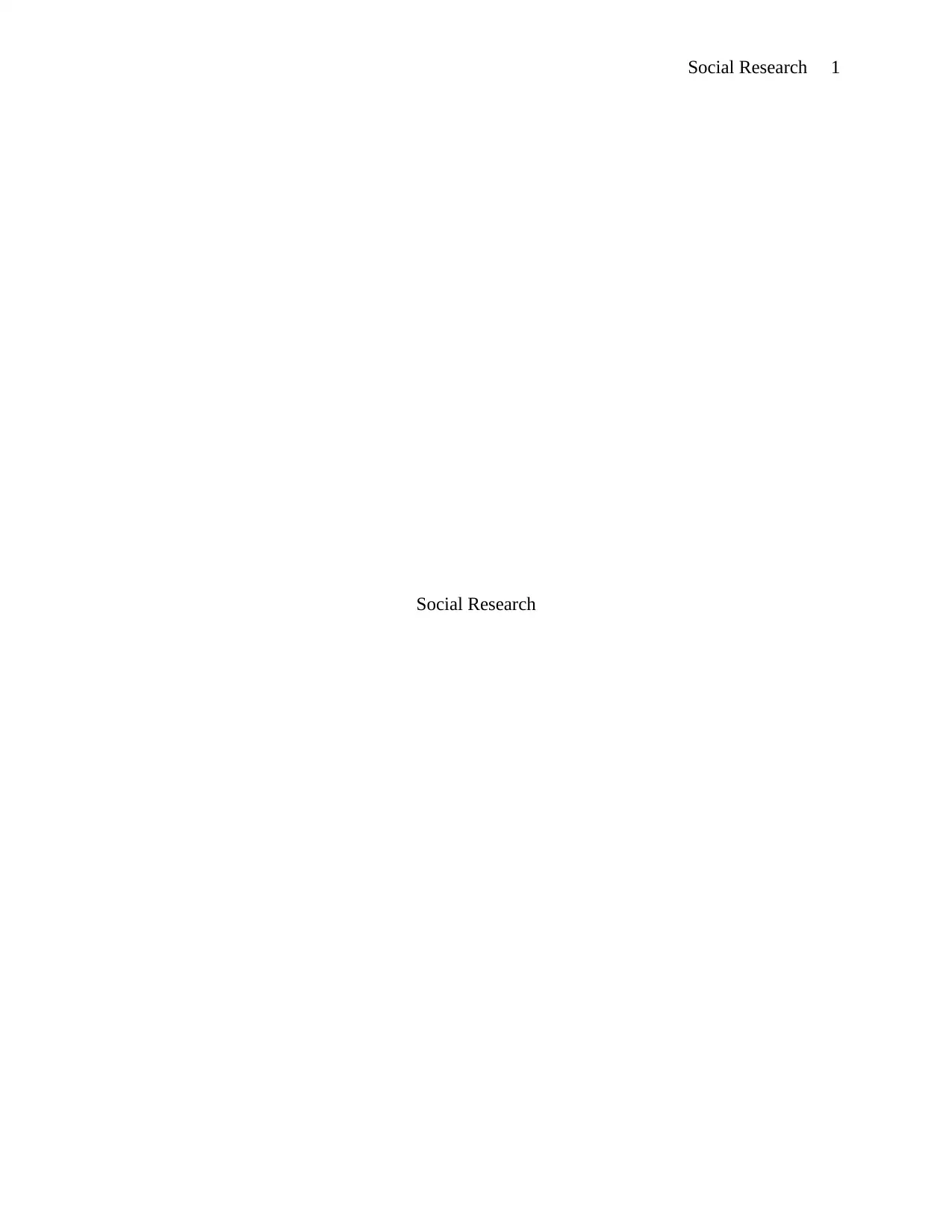
Social Research 1
Social Research
Social Research
Paraphrase This Document
Need a fresh take? Get an instant paraphrase of this document with our AI Paraphraser
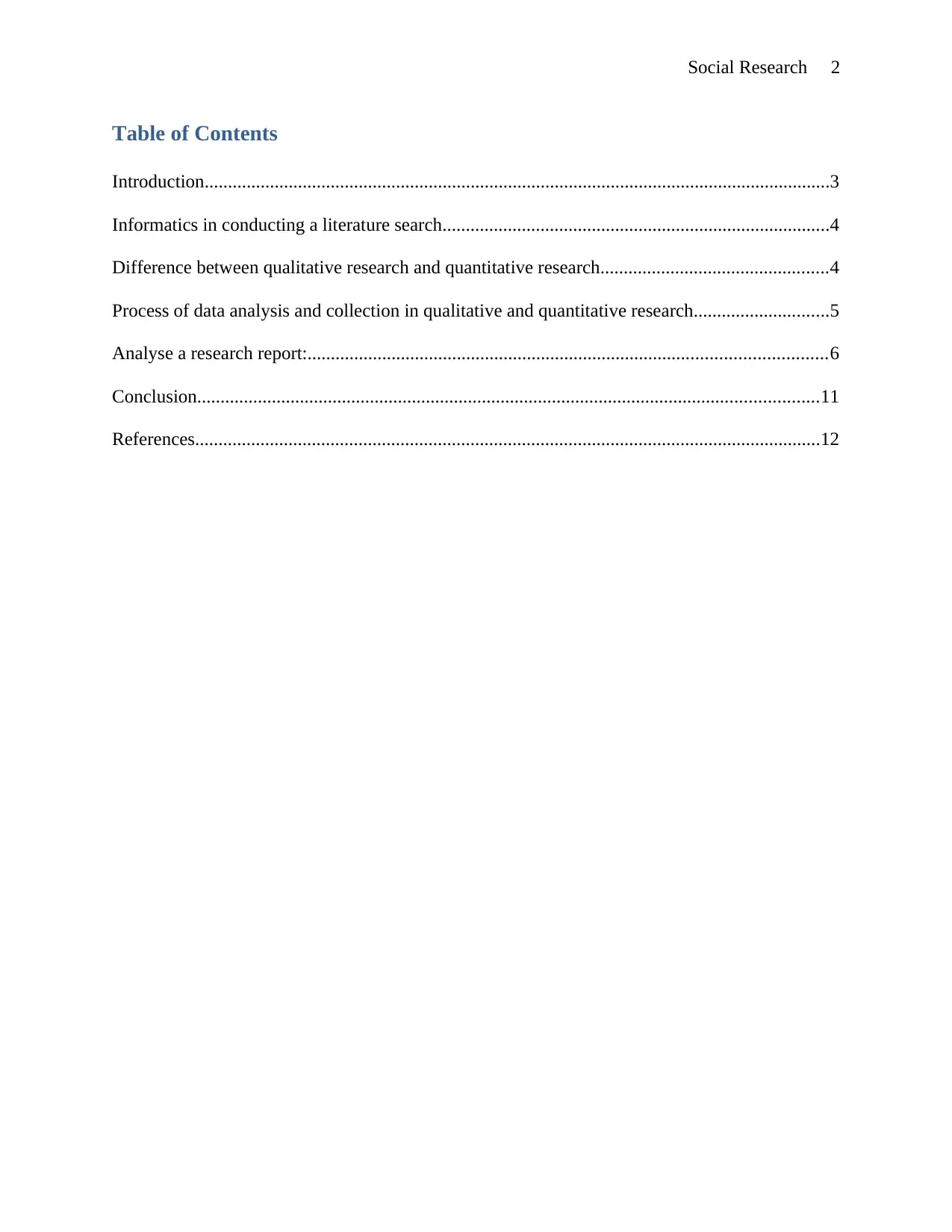
Social Research 2
Table of Contents
Introduction......................................................................................................................................3
Informatics in conducting a literature search...................................................................................4
Difference between qualitative research and quantitative research.................................................4
Process of data analysis and collection in qualitative and quantitative research.............................5
Analyse a research report:...............................................................................................................6
Conclusion.....................................................................................................................................11
References......................................................................................................................................12
Table of Contents
Introduction......................................................................................................................................3
Informatics in conducting a literature search...................................................................................4
Difference between qualitative research and quantitative research.................................................4
Process of data analysis and collection in qualitative and quantitative research.............................5
Analyse a research report:...............................................................................................................6
Conclusion.....................................................................................................................................11
References......................................................................................................................................12
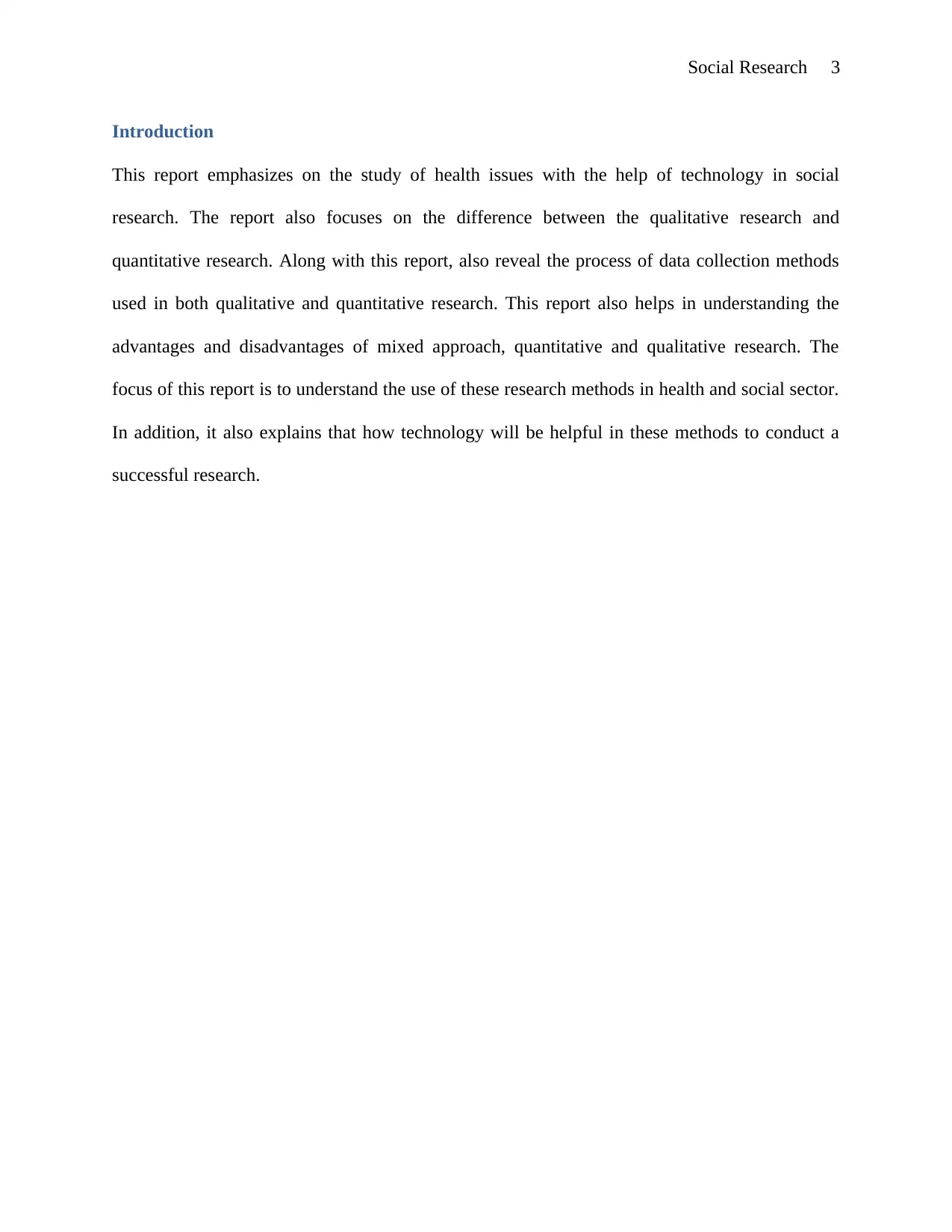
Social Research 3
Introduction
This report emphasizes on the study of health issues with the help of technology in social
research. The report also focuses on the difference between the qualitative research and
quantitative research. Along with this report, also reveal the process of data collection methods
used in both qualitative and quantitative research. This report also helps in understanding the
advantages and disadvantages of mixed approach, quantitative and qualitative research. The
focus of this report is to understand the use of these research methods in health and social sector.
In addition, it also explains that how technology will be helpful in these methods to conduct a
successful research.
Introduction
This report emphasizes on the study of health issues with the help of technology in social
research. The report also focuses on the difference between the qualitative research and
quantitative research. Along with this report, also reveal the process of data collection methods
used in both qualitative and quantitative research. This report also helps in understanding the
advantages and disadvantages of mixed approach, quantitative and qualitative research. The
focus of this report is to understand the use of these research methods in health and social sector.
In addition, it also explains that how technology will be helpful in these methods to conduct a
successful research.
⊘ This is a preview!⊘
Do you want full access?
Subscribe today to unlock all pages.

Trusted by 1+ million students worldwide
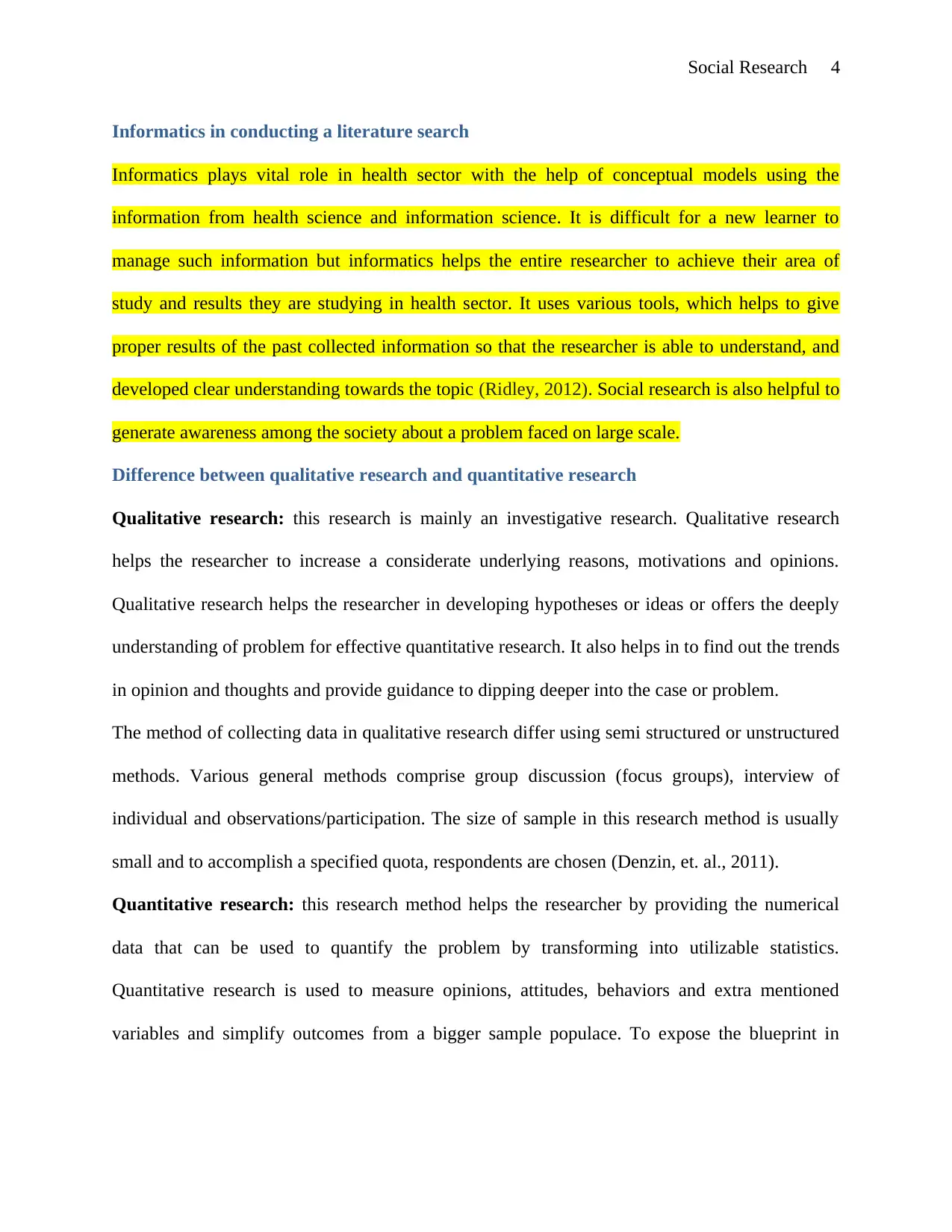
Social Research 4
Informatics in conducting a literature search
Informatics plays vital role in health sector with the help of conceptual models using the
information from health science and information science. It is difficult for a new learner to
manage such information but informatics helps the entire researcher to achieve their area of
study and results they are studying in health sector. It uses various tools, which helps to give
proper results of the past collected information so that the researcher is able to understand, and
developed clear understanding towards the topic (Ridley, 2012). Social research is also helpful to
generate awareness among the society about a problem faced on large scale.
Difference between qualitative research and quantitative research
Qualitative research: this research is mainly an investigative research. Qualitative research
helps the researcher to increase a considerate underlying reasons, motivations and opinions.
Qualitative research helps the researcher in developing hypotheses or ideas or offers the deeply
understanding of problem for effective quantitative research. It also helps in to find out the trends
in opinion and thoughts and provide guidance to dipping deeper into the case or problem.
The method of collecting data in qualitative research differ using semi structured or unstructured
methods. Various general methods comprise group discussion (focus groups), interview of
individual and observations/participation. The size of sample in this research method is usually
small and to accomplish a specified quota, respondents are chosen (Denzin, et. al., 2011).
Quantitative research: this research method helps the researcher by providing the numerical
data that can be used to quantify the problem by transforming into utilizable statistics.
Quantitative research is used to measure opinions, attitudes, behaviors and extra mentioned
variables and simplify outcomes from a bigger sample populace. To expose the blueprint in
Informatics in conducting a literature search
Informatics plays vital role in health sector with the help of conceptual models using the
information from health science and information science. It is difficult for a new learner to
manage such information but informatics helps the entire researcher to achieve their area of
study and results they are studying in health sector. It uses various tools, which helps to give
proper results of the past collected information so that the researcher is able to understand, and
developed clear understanding towards the topic (Ridley, 2012). Social research is also helpful to
generate awareness among the society about a problem faced on large scale.
Difference between qualitative research and quantitative research
Qualitative research: this research is mainly an investigative research. Qualitative research
helps the researcher to increase a considerate underlying reasons, motivations and opinions.
Qualitative research helps the researcher in developing hypotheses or ideas or offers the deeply
understanding of problem for effective quantitative research. It also helps in to find out the trends
in opinion and thoughts and provide guidance to dipping deeper into the case or problem.
The method of collecting data in qualitative research differ using semi structured or unstructured
methods. Various general methods comprise group discussion (focus groups), interview of
individual and observations/participation. The size of sample in this research method is usually
small and to accomplish a specified quota, respondents are chosen (Denzin, et. al., 2011).
Quantitative research: this research method helps the researcher by providing the numerical
data that can be used to quantify the problem by transforming into utilizable statistics.
Quantitative research is used to measure opinions, attitudes, behaviors and extra mentioned
variables and simplify outcomes from a bigger sample populace. To expose the blueprint in
Paraphrase This Document
Need a fresh take? Get an instant paraphrase of this document with our AI Paraphraser
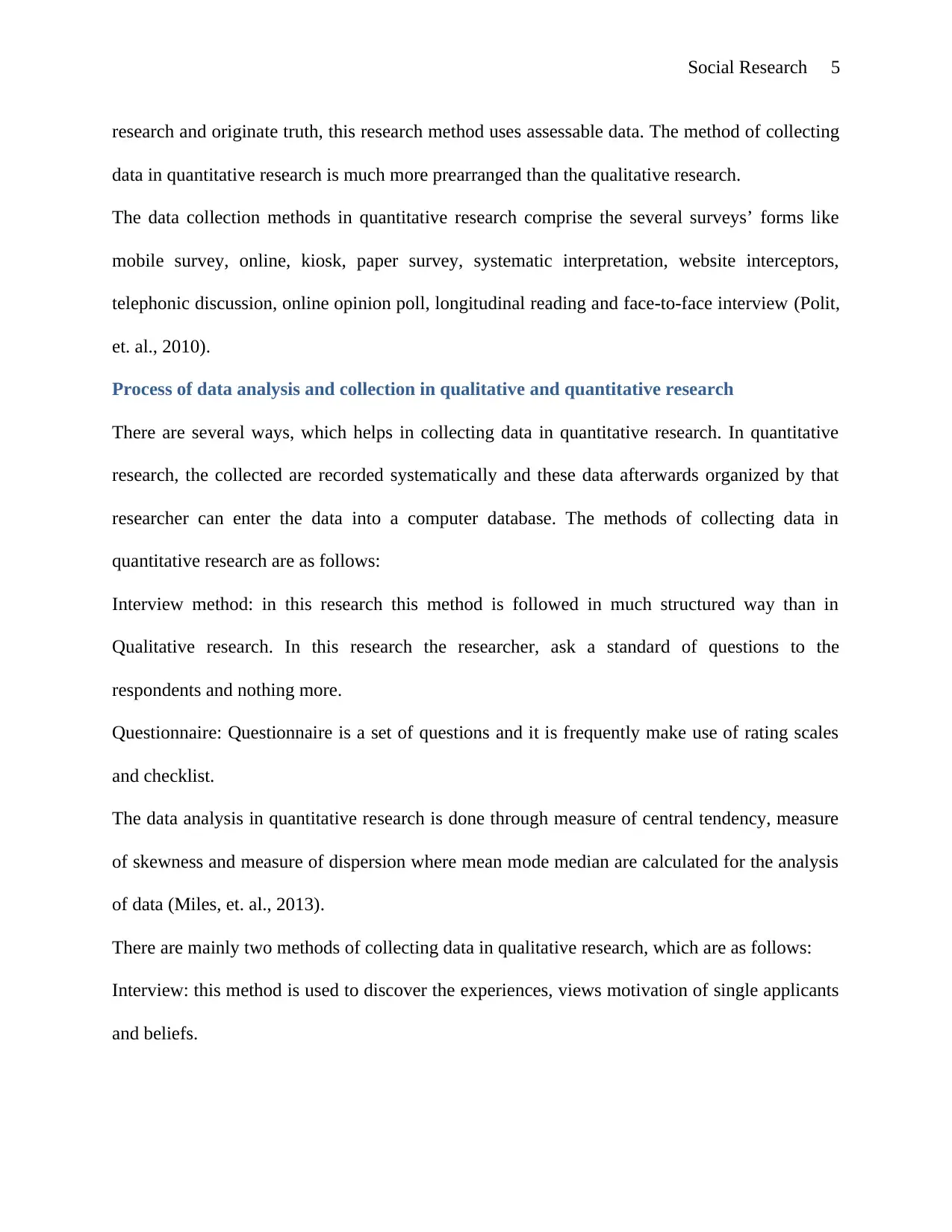
Social Research 5
research and originate truth, this research method uses assessable data. The method of collecting
data in quantitative research is much more prearranged than the qualitative research.
The data collection methods in quantitative research comprise the several surveys’ forms like
mobile survey, online, kiosk, paper survey, systematic interpretation, website interceptors,
telephonic discussion, online opinion poll, longitudinal reading and face-to-face interview (Polit,
et. al., 2010).
Process of data analysis and collection in qualitative and quantitative research
There are several ways, which helps in collecting data in quantitative research. In quantitative
research, the collected are recorded systematically and these data afterwards organized by that
researcher can enter the data into a computer database. The methods of collecting data in
quantitative research are as follows:
Interview method: in this research this method is followed in much structured way than in
Qualitative research. In this research the researcher, ask a standard of questions to the
respondents and nothing more.
Questionnaire: Questionnaire is a set of questions and it is frequently make use of rating scales
and checklist.
The data analysis in quantitative research is done through measure of central tendency, measure
of skewness and measure of dispersion where mean mode median are calculated for the analysis
of data (Miles, et. al., 2013).
There are mainly two methods of collecting data in qualitative research, which are as follows:
Interview: this method is used to discover the experiences, views motivation of single applicants
and beliefs.
research and originate truth, this research method uses assessable data. The method of collecting
data in quantitative research is much more prearranged than the qualitative research.
The data collection methods in quantitative research comprise the several surveys’ forms like
mobile survey, online, kiosk, paper survey, systematic interpretation, website interceptors,
telephonic discussion, online opinion poll, longitudinal reading and face-to-face interview (Polit,
et. al., 2010).
Process of data analysis and collection in qualitative and quantitative research
There are several ways, which helps in collecting data in quantitative research. In quantitative
research, the collected are recorded systematically and these data afterwards organized by that
researcher can enter the data into a computer database. The methods of collecting data in
quantitative research are as follows:
Interview method: in this research this method is followed in much structured way than in
Qualitative research. In this research the researcher, ask a standard of questions to the
respondents and nothing more.
Questionnaire: Questionnaire is a set of questions and it is frequently make use of rating scales
and checklist.
The data analysis in quantitative research is done through measure of central tendency, measure
of skewness and measure of dispersion where mean mode median are calculated for the analysis
of data (Miles, et. al., 2013).
There are mainly two methods of collecting data in qualitative research, which are as follows:
Interview: this method is used to discover the experiences, views motivation of single applicants
and beliefs.
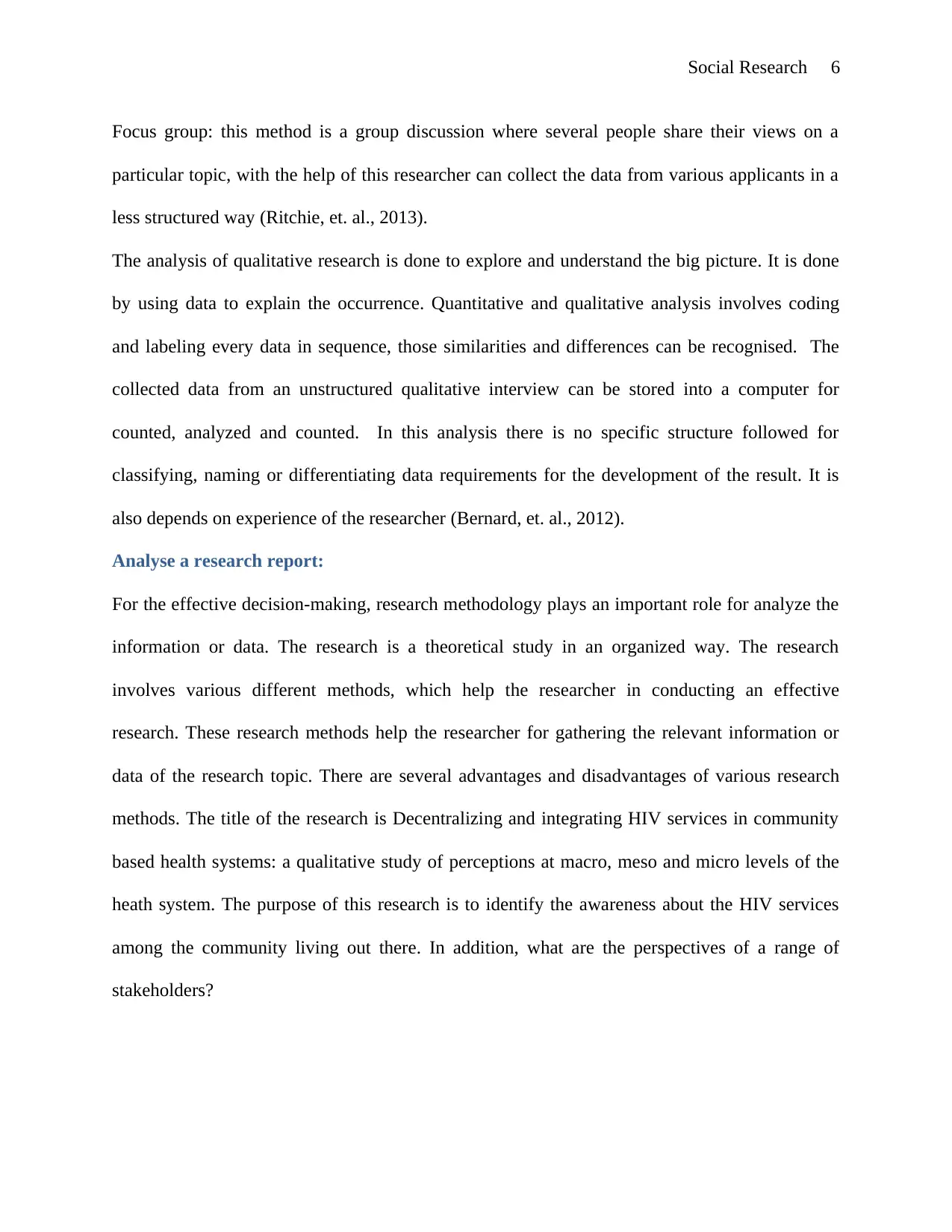
Social Research 6
Focus group: this method is a group discussion where several people share their views on a
particular topic, with the help of this researcher can collect the data from various applicants in a
less structured way (Ritchie, et. al., 2013).
The analysis of qualitative research is done to explore and understand the big picture. It is done
by using data to explain the occurrence. Quantitative and qualitative analysis involves coding
and labeling every data in sequence, those similarities and differences can be recognised. The
collected data from an unstructured qualitative interview can be stored into a computer for
counted, analyzed and counted. In this analysis there is no specific structure followed for
classifying, naming or differentiating data requirements for the development of the result. It is
also depends on experience of the researcher (Bernard, et. al., 2012).
Analyse a research report:
For the effective decision-making, research methodology plays an important role for analyze the
information or data. The research is a theoretical study in an organized way. The research
involves various different methods, which help the researcher in conducting an effective
research. These research methods help the researcher for gathering the relevant information or
data of the research topic. There are several advantages and disadvantages of various research
methods. The title of the research is Decentralizing and integrating HIV services in community
based health systems: a qualitative study of perceptions at macro, meso and micro levels of the
heath system. The purpose of this research is to identify the awareness about the HIV services
among the community living out there. In addition, what are the perspectives of a range of
stakeholders?
Focus group: this method is a group discussion where several people share their views on a
particular topic, with the help of this researcher can collect the data from various applicants in a
less structured way (Ritchie, et. al., 2013).
The analysis of qualitative research is done to explore and understand the big picture. It is done
by using data to explain the occurrence. Quantitative and qualitative analysis involves coding
and labeling every data in sequence, those similarities and differences can be recognised. The
collected data from an unstructured qualitative interview can be stored into a computer for
counted, analyzed and counted. In this analysis there is no specific structure followed for
classifying, naming or differentiating data requirements for the development of the result. It is
also depends on experience of the researcher (Bernard, et. al., 2012).
Analyse a research report:
For the effective decision-making, research methodology plays an important role for analyze the
information or data. The research is a theoretical study in an organized way. The research
involves various different methods, which help the researcher in conducting an effective
research. These research methods help the researcher for gathering the relevant information or
data of the research topic. There are several advantages and disadvantages of various research
methods. The title of the research is Decentralizing and integrating HIV services in community
based health systems: a qualitative study of perceptions at macro, meso and micro levels of the
heath system. The purpose of this research is to identify the awareness about the HIV services
among the community living out there. In addition, what are the perspectives of a range of
stakeholders?
⊘ This is a preview!⊘
Do you want full access?
Subscribe today to unlock all pages.

Trusted by 1+ million students worldwide
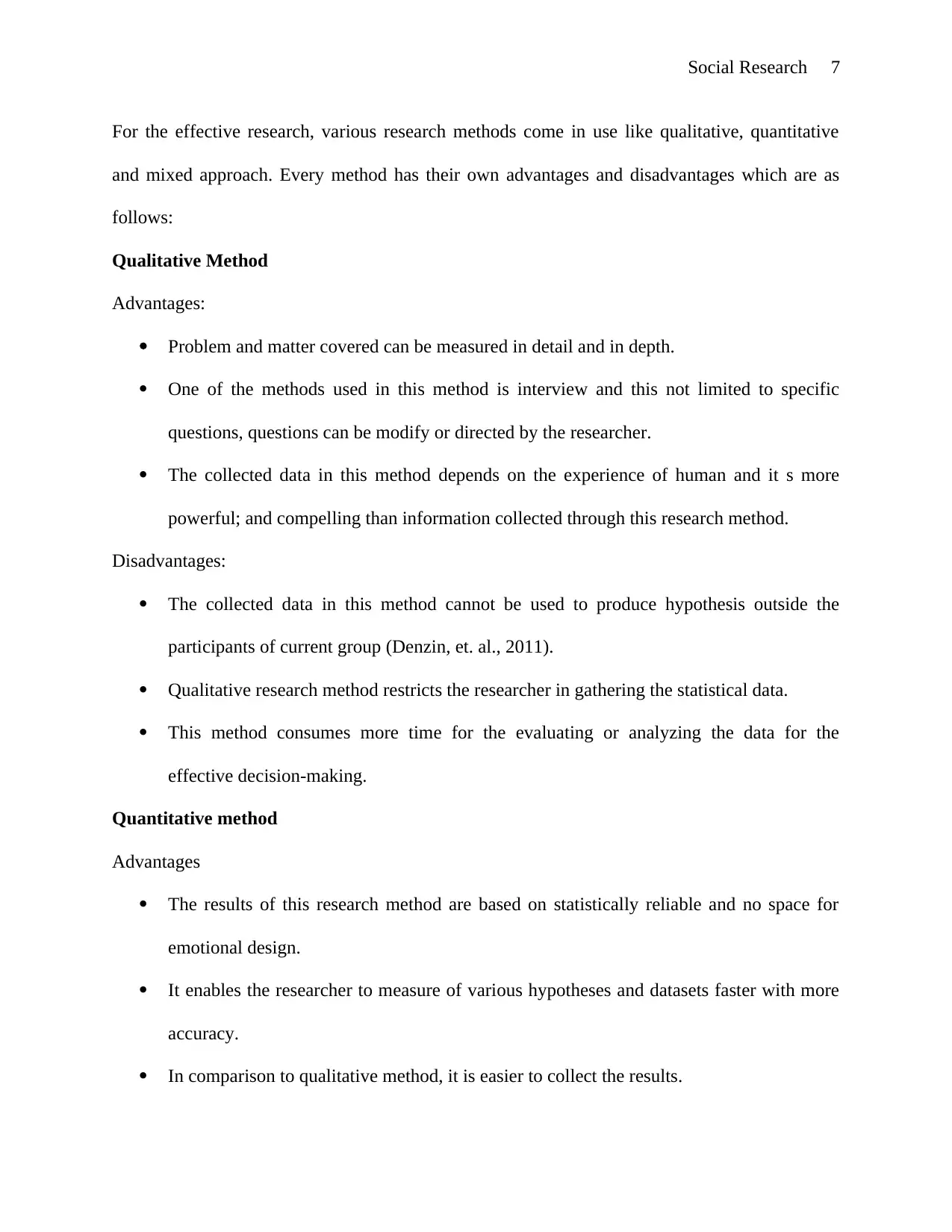
Social Research 7
For the effective research, various research methods come in use like qualitative, quantitative
and mixed approach. Every method has their own advantages and disadvantages which are as
follows:
Qualitative Method
Advantages:
Problem and matter covered can be measured in detail and in depth.
One of the methods used in this method is interview and this not limited to specific
questions, questions can be modify or directed by the researcher.
The collected data in this method depends on the experience of human and it s more
powerful; and compelling than information collected through this research method.
Disadvantages:
The collected data in this method cannot be used to produce hypothesis outside the
participants of current group (Denzin, et. al., 2011).
Qualitative research method restricts the researcher in gathering the statistical data.
This method consumes more time for the evaluating or analyzing the data for the
effective decision-making.
Quantitative method
Advantages
The results of this research method are based on statistically reliable and no space for
emotional design.
It enables the researcher to measure of various hypotheses and datasets faster with more
accuracy.
In comparison to qualitative method, it is easier to collect the results.
For the effective research, various research methods come in use like qualitative, quantitative
and mixed approach. Every method has their own advantages and disadvantages which are as
follows:
Qualitative Method
Advantages:
Problem and matter covered can be measured in detail and in depth.
One of the methods used in this method is interview and this not limited to specific
questions, questions can be modify or directed by the researcher.
The collected data in this method depends on the experience of human and it s more
powerful; and compelling than information collected through this research method.
Disadvantages:
The collected data in this method cannot be used to produce hypothesis outside the
participants of current group (Denzin, et. al., 2011).
Qualitative research method restricts the researcher in gathering the statistical data.
This method consumes more time for the evaluating or analyzing the data for the
effective decision-making.
Quantitative method
Advantages
The results of this research method are based on statistically reliable and no space for
emotional design.
It enables the researcher to measure of various hypotheses and datasets faster with more
accuracy.
In comparison to qualitative method, it is easier to collect the results.
Paraphrase This Document
Need a fresh take? Get an instant paraphrase of this document with our AI Paraphraser
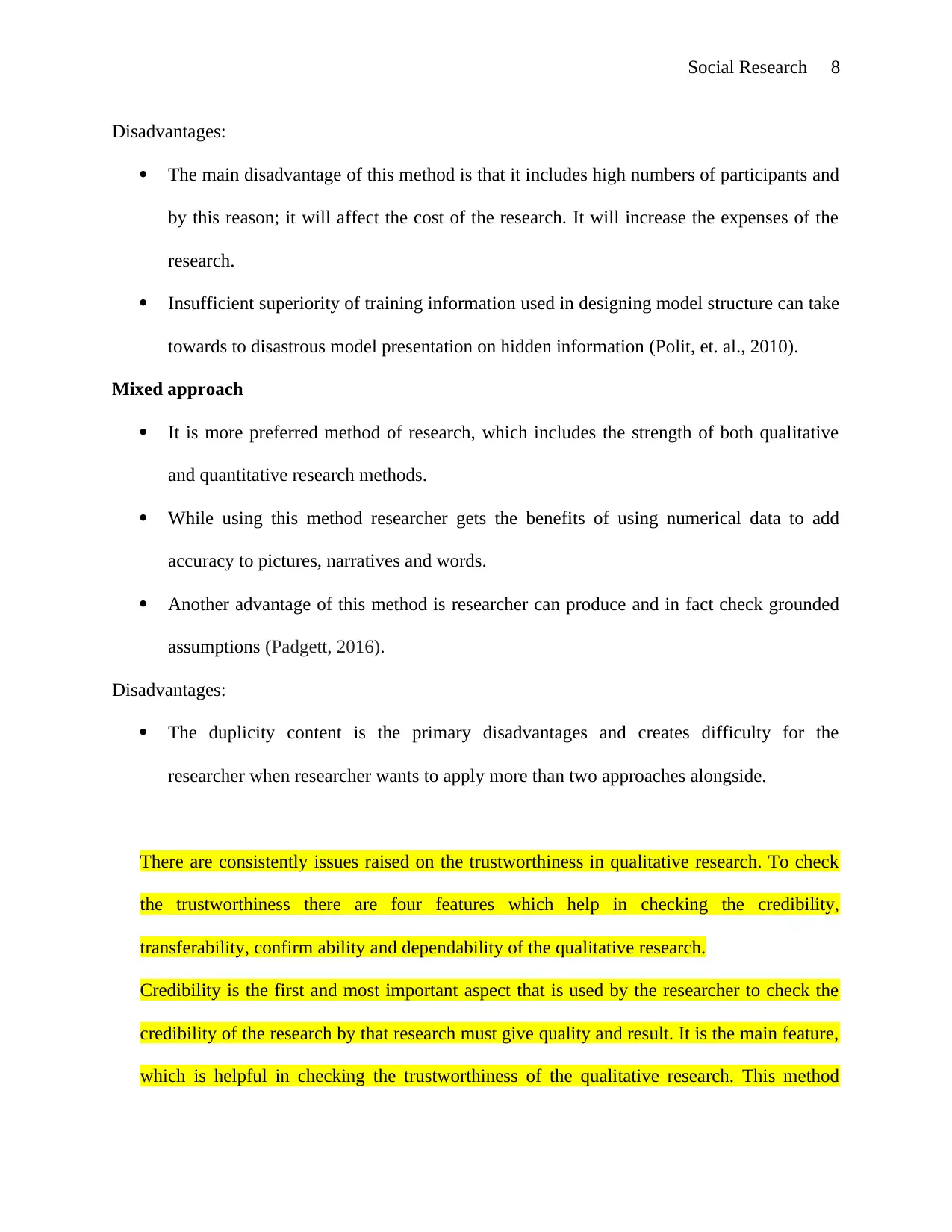
Social Research 8
Disadvantages:
The main disadvantage of this method is that it includes high numbers of participants and
by this reason; it will affect the cost of the research. It will increase the expenses of the
research.
Insufficient superiority of training information used in designing model structure can take
towards to disastrous model presentation on hidden information (Polit, et. al., 2010).
Mixed approach
It is more preferred method of research, which includes the strength of both qualitative
and quantitative research methods.
While using this method researcher gets the benefits of using numerical data to add
accuracy to pictures, narratives and words.
Another advantage of this method is researcher can produce and in fact check grounded
assumptions (Padgett, 2016).
Disadvantages:
The duplicity content is the primary disadvantages and creates difficulty for the
researcher when researcher wants to apply more than two approaches alongside.
There are consistently issues raised on the trustworthiness in qualitative research. To check
the trustworthiness there are four features which help in checking the credibility,
transferability, confirm ability and dependability of the qualitative research.
Credibility is the first and most important aspect that is used by the researcher to check the
credibility of the research by that research must give quality and result. It is the main feature,
which is helpful in checking the trustworthiness of the qualitative research. This method
Disadvantages:
The main disadvantage of this method is that it includes high numbers of participants and
by this reason; it will affect the cost of the research. It will increase the expenses of the
research.
Insufficient superiority of training information used in designing model structure can take
towards to disastrous model presentation on hidden information (Polit, et. al., 2010).
Mixed approach
It is more preferred method of research, which includes the strength of both qualitative
and quantitative research methods.
While using this method researcher gets the benefits of using numerical data to add
accuracy to pictures, narratives and words.
Another advantage of this method is researcher can produce and in fact check grounded
assumptions (Padgett, 2016).
Disadvantages:
The duplicity content is the primary disadvantages and creates difficulty for the
researcher when researcher wants to apply more than two approaches alongside.
There are consistently issues raised on the trustworthiness in qualitative research. To check
the trustworthiness there are four features which help in checking the credibility,
transferability, confirm ability and dependability of the qualitative research.
Credibility is the first and most important aspect that is used by the researcher to check the
credibility of the research by that research must give quality and result. It is the main feature,
which is helpful in checking the trustworthiness of the qualitative research. This method
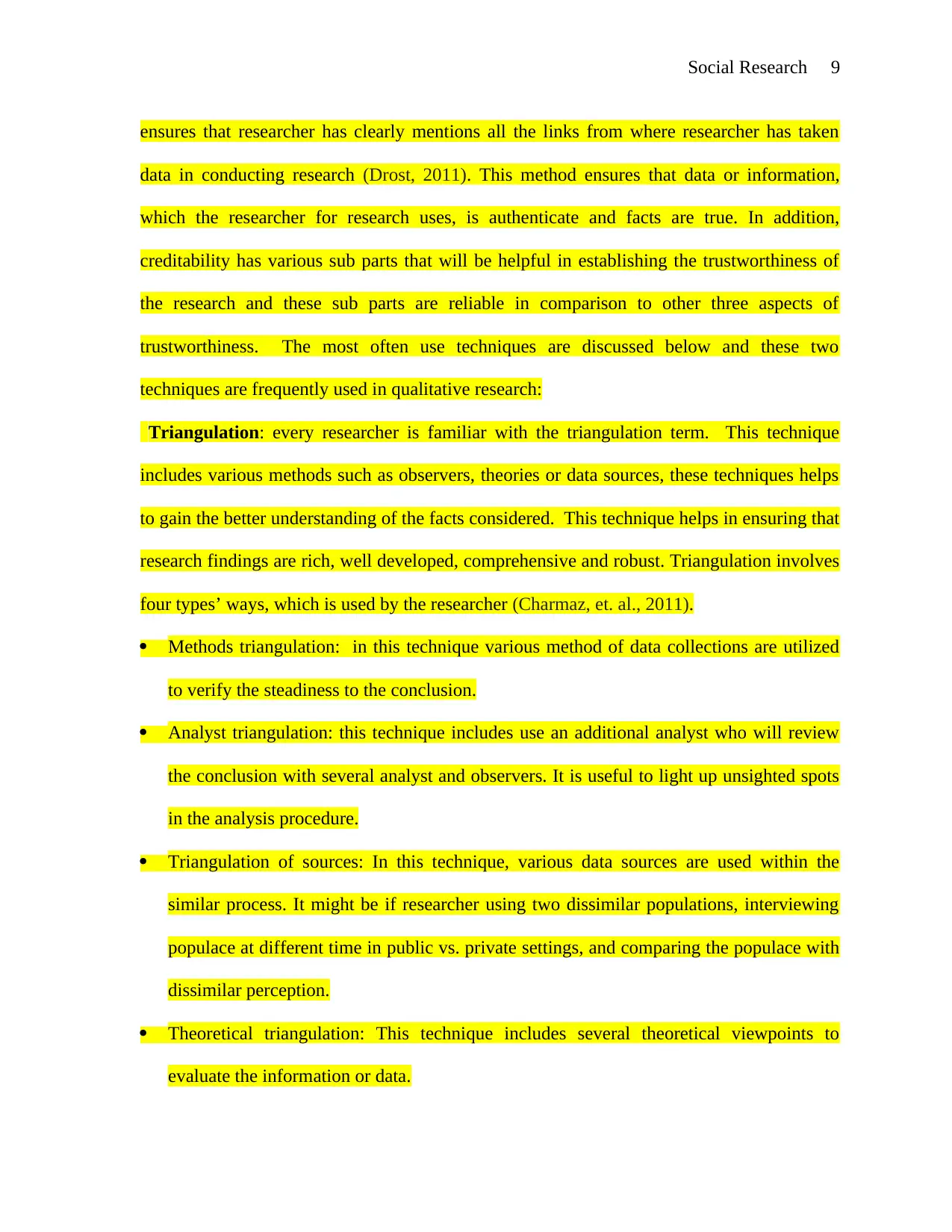
Social Research 9
ensures that researcher has clearly mentions all the links from where researcher has taken
data in conducting research (Drost, 2011). This method ensures that data or information,
which the researcher for research uses, is authenticate and facts are true. In addition,
creditability has various sub parts that will be helpful in establishing the trustworthiness of
the research and these sub parts are reliable in comparison to other three aspects of
trustworthiness. The most often use techniques are discussed below and these two
techniques are frequently used in qualitative research:
Triangulation: every researcher is familiar with the triangulation term. This technique
includes various methods such as observers, theories or data sources, these techniques helps
to gain the better understanding of the facts considered. This technique helps in ensuring that
research findings are rich, well developed, comprehensive and robust. Triangulation involves
four types’ ways, which is used by the researcher (Charmaz, et. al., 2011).
Methods triangulation: in this technique various method of data collections are utilized
to verify the steadiness to the conclusion.
Analyst triangulation: this technique includes use an additional analyst who will review
the conclusion with several analyst and observers. It is useful to light up unsighted spots
in the analysis procedure.
Triangulation of sources: In this technique, various data sources are used within the
similar process. It might be if researcher using two dissimilar populations, interviewing
populace at different time in public vs. private settings, and comparing the populace with
dissimilar perception.
Theoretical triangulation: This technique includes several theoretical viewpoints to
evaluate the information or data.
ensures that researcher has clearly mentions all the links from where researcher has taken
data in conducting research (Drost, 2011). This method ensures that data or information,
which the researcher for research uses, is authenticate and facts are true. In addition,
creditability has various sub parts that will be helpful in establishing the trustworthiness of
the research and these sub parts are reliable in comparison to other three aspects of
trustworthiness. The most often use techniques are discussed below and these two
techniques are frequently used in qualitative research:
Triangulation: every researcher is familiar with the triangulation term. This technique
includes various methods such as observers, theories or data sources, these techniques helps
to gain the better understanding of the facts considered. This technique helps in ensuring that
research findings are rich, well developed, comprehensive and robust. Triangulation involves
four types’ ways, which is used by the researcher (Charmaz, et. al., 2011).
Methods triangulation: in this technique various method of data collections are utilized
to verify the steadiness to the conclusion.
Analyst triangulation: this technique includes use an additional analyst who will review
the conclusion with several analyst and observers. It is useful to light up unsighted spots
in the analysis procedure.
Triangulation of sources: In this technique, various data sources are used within the
similar process. It might be if researcher using two dissimilar populations, interviewing
populace at different time in public vs. private settings, and comparing the populace with
dissimilar perception.
Theoretical triangulation: This technique includes several theoretical viewpoints to
evaluate the information or data.
⊘ This is a preview!⊘
Do you want full access?
Subscribe today to unlock all pages.

Trusted by 1+ million students worldwide
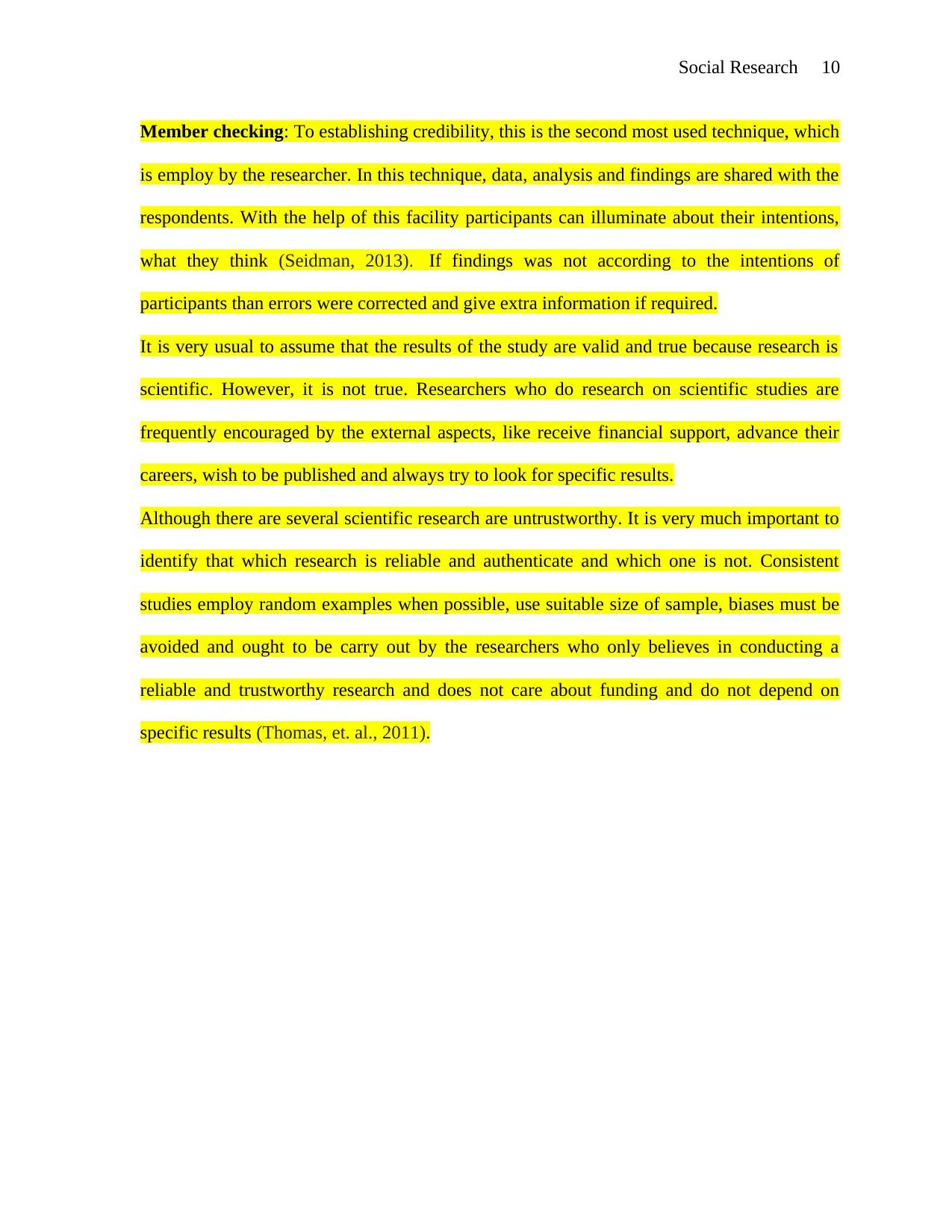
Social Research 10
Member checking: To establishing credibility, this is the second most used technique, which
is employ by the researcher. In this technique, data, analysis and findings are shared with the
respondents. With the help of this facility participants can illuminate about their intentions,
what they think (Seidman, 2013). If findings was not according to the intentions of
participants than errors were corrected and give extra information if required.
It is very usual to assume that the results of the study are valid and true because research is
scientific. However, it is not true. Researchers who do research on scientific studies are
frequently encouraged by the external aspects, like receive financial support, advance their
careers, wish to be published and always try to look for specific results.
Although there are several scientific research are untrustworthy. It is very much important to
identify that which research is reliable and authenticate and which one is not. Consistent
studies employ random examples when possible, use suitable size of sample, biases must be
avoided and ought to be carry out by the researchers who only believes in conducting a
reliable and trustworthy research and does not care about funding and do not depend on
specific results (Thomas, et. al., 2011).
Member checking: To establishing credibility, this is the second most used technique, which
is employ by the researcher. In this technique, data, analysis and findings are shared with the
respondents. With the help of this facility participants can illuminate about their intentions,
what they think (Seidman, 2013). If findings was not according to the intentions of
participants than errors were corrected and give extra information if required.
It is very usual to assume that the results of the study are valid and true because research is
scientific. However, it is not true. Researchers who do research on scientific studies are
frequently encouraged by the external aspects, like receive financial support, advance their
careers, wish to be published and always try to look for specific results.
Although there are several scientific research are untrustworthy. It is very much important to
identify that which research is reliable and authenticate and which one is not. Consistent
studies employ random examples when possible, use suitable size of sample, biases must be
avoided and ought to be carry out by the researchers who only believes in conducting a
reliable and trustworthy research and does not care about funding and do not depend on
specific results (Thomas, et. al., 2011).
Paraphrase This Document
Need a fresh take? Get an instant paraphrase of this document with our AI Paraphraser
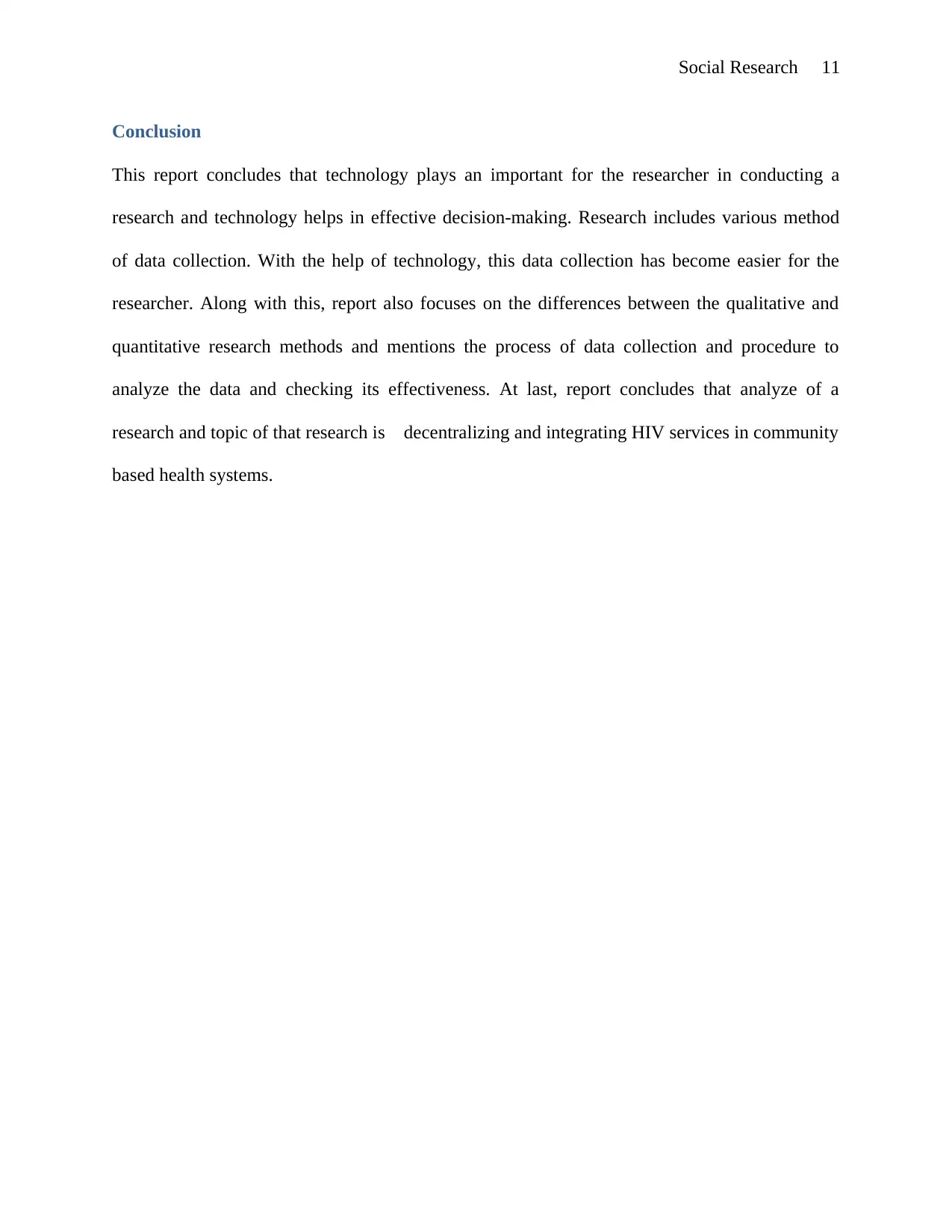
Social Research 11
Conclusion
This report concludes that technology plays an important for the researcher in conducting a
research and technology helps in effective decision-making. Research includes various method
of data collection. With the help of technology, this data collection has become easier for the
researcher. Along with this, report also focuses on the differences between the qualitative and
quantitative research methods and mentions the process of data collection and procedure to
analyze the data and checking its effectiveness. At last, report concludes that analyze of a
research and topic of that research is decentralizing and integrating HIV services in community
based health systems.
Conclusion
This report concludes that technology plays an important for the researcher in conducting a
research and technology helps in effective decision-making. Research includes various method
of data collection. With the help of technology, this data collection has become easier for the
researcher. Along with this, report also focuses on the differences between the qualitative and
quantitative research methods and mentions the process of data collection and procedure to
analyze the data and checking its effectiveness. At last, report concludes that analyze of a
research and topic of that research is decentralizing and integrating HIV services in community
based health systems.
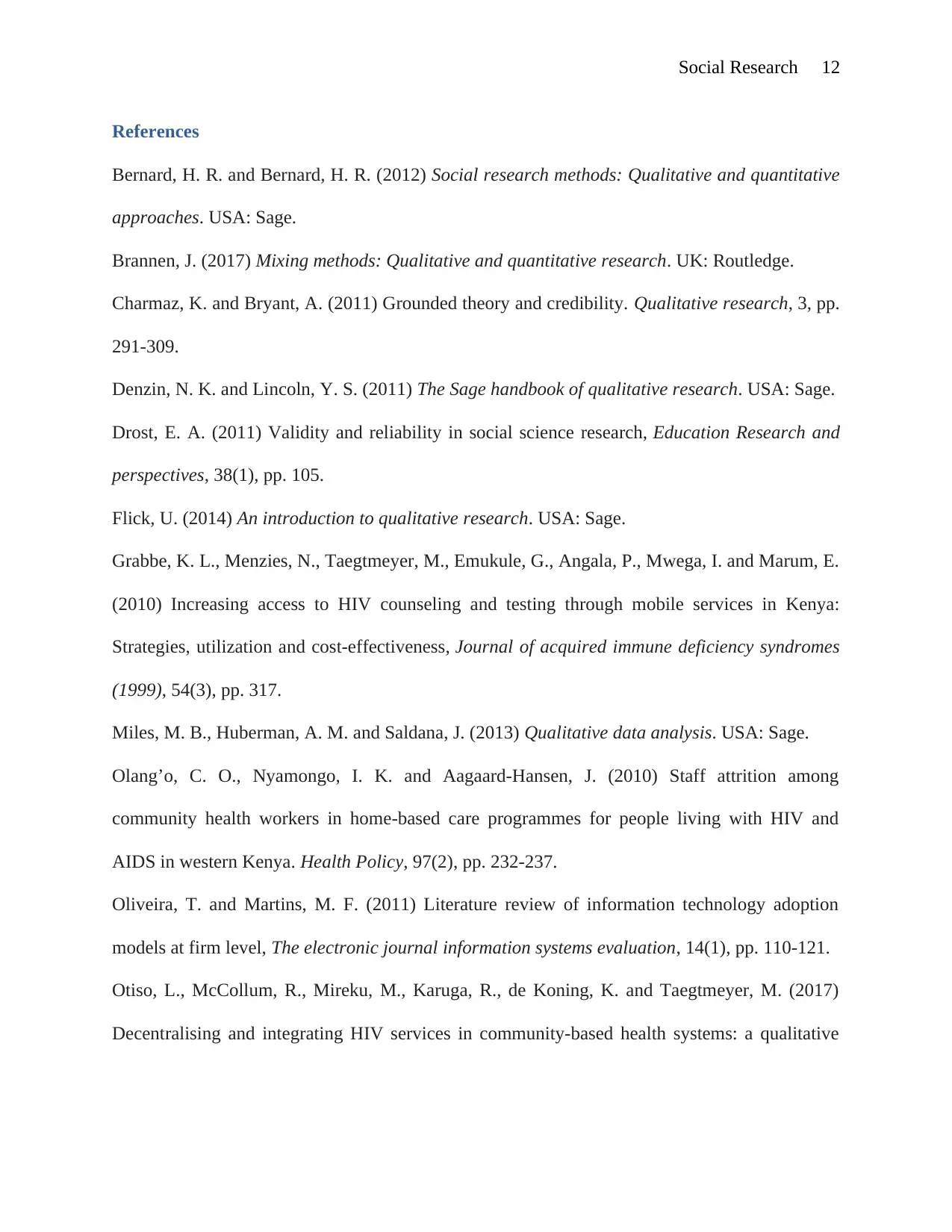
Social Research 12
References
Bernard, H. R. and Bernard, H. R. (2012) Social research methods: Qualitative and quantitative
approaches. USA: Sage.
Brannen, J. (2017) Mixing methods: Qualitative and quantitative research. UK: Routledge.
Charmaz, K. and Bryant, A. (2011) Grounded theory and credibility. Qualitative research, 3, pp.
291-309.
Denzin, N. K. and Lincoln, Y. S. (2011) The Sage handbook of qualitative research. USA: Sage.
Drost, E. A. (2011) Validity and reliability in social science research, Education Research and
perspectives, 38(1), pp. 105.
Flick, U. (2014) An introduction to qualitative research. USA: Sage.
Grabbe, K. L., Menzies, N., Taegtmeyer, M., Emukule, G., Angala, P., Mwega, I. and Marum, E.
(2010) Increasing access to HIV counseling and testing through mobile services in Kenya:
Strategies, utilization and cost-effectiveness, Journal of acquired immune deficiency syndromes
(1999), 54(3), pp. 317.
Miles, M. B., Huberman, A. M. and Saldana, J. (2013) Qualitative data analysis. USA: Sage.
Olang’o, C. O., Nyamongo, I. K. and Aagaard-Hansen, J. (2010) Staff attrition among
community health workers in home-based care programmes for people living with HIV and
AIDS in western Kenya. Health Policy, 97(2), pp. 232-237.
Oliveira, T. and Martins, M. F. (2011) Literature review of information technology adoption
models at firm level, The electronic journal information systems evaluation, 14(1), pp. 110-121.
Otiso, L., McCollum, R., Mireku, M., Karuga, R., de Koning, K. and Taegtmeyer, M. (2017)
Decentralising and integrating HIV services in community-based health systems: a qualitative
References
Bernard, H. R. and Bernard, H. R. (2012) Social research methods: Qualitative and quantitative
approaches. USA: Sage.
Brannen, J. (2017) Mixing methods: Qualitative and quantitative research. UK: Routledge.
Charmaz, K. and Bryant, A. (2011) Grounded theory and credibility. Qualitative research, 3, pp.
291-309.
Denzin, N. K. and Lincoln, Y. S. (2011) The Sage handbook of qualitative research. USA: Sage.
Drost, E. A. (2011) Validity and reliability in social science research, Education Research and
perspectives, 38(1), pp. 105.
Flick, U. (2014) An introduction to qualitative research. USA: Sage.
Grabbe, K. L., Menzies, N., Taegtmeyer, M., Emukule, G., Angala, P., Mwega, I. and Marum, E.
(2010) Increasing access to HIV counseling and testing through mobile services in Kenya:
Strategies, utilization and cost-effectiveness, Journal of acquired immune deficiency syndromes
(1999), 54(3), pp. 317.
Miles, M. B., Huberman, A. M. and Saldana, J. (2013) Qualitative data analysis. USA: Sage.
Olang’o, C. O., Nyamongo, I. K. and Aagaard-Hansen, J. (2010) Staff attrition among
community health workers in home-based care programmes for people living with HIV and
AIDS in western Kenya. Health Policy, 97(2), pp. 232-237.
Oliveira, T. and Martins, M. F. (2011) Literature review of information technology adoption
models at firm level, The electronic journal information systems evaluation, 14(1), pp. 110-121.
Otiso, L., McCollum, R., Mireku, M., Karuga, R., de Koning, K. and Taegtmeyer, M. (2017)
Decentralising and integrating HIV services in community-based health systems: a qualitative
⊘ This is a preview!⊘
Do you want full access?
Subscribe today to unlock all pages.

Trusted by 1+ million students worldwide
1 out of 13
Related Documents
Your All-in-One AI-Powered Toolkit for Academic Success.
+13062052269
info@desklib.com
Available 24*7 on WhatsApp / Email
![[object Object]](/_next/static/media/star-bottom.7253800d.svg)
Unlock your academic potential
Copyright © 2020–2025 A2Z Services. All Rights Reserved. Developed and managed by ZUCOL.




